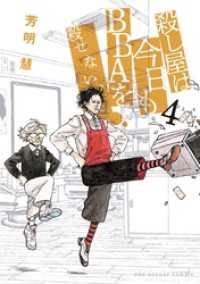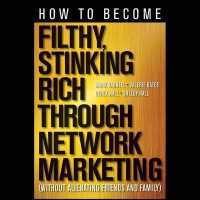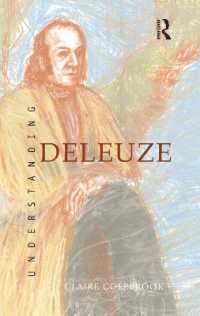Full Description
-->Teaches students the ways to understand, explain, control, and prevent juvenile delinquency. Taking a sociological approach, this text discusses delinquency as it relates to and emerges from the youth's family, neighborhood, school, peer group, social class, and overall cultural and social environment. The authors incorporate contributions from sociologists, psychologists, social workers, criminologists, and other specialists, who have sought to understand, explain, control, and prevent juvenile delinquency.Learning GoalsUpon completing this book, readers will be able to:Understand the causes of juvenile delinquency in both the US and other countries. Use theoretical ideas to explain the cause of juvenile delinquency. Discuss preventive measures to juvenile delinquency. Analyze various studies on juvenile delinquency and apply theories to real-life situations. 0205246532 / 9780205246533 Juvenile Delinquency
Contents
In this Section1. Brief Table of Contents2. Full Table of Contents1. Brief Table of ContentsPart 1: Conformity, Deviance, and Juvenile Delinquency Chapter 1: A Sociological Approach to Juvenile Delinquency Chapter 2: Dimensions of Juvenile Delinquency Part 2: Causes of Juvenile Delinquency Chapter 3: Classical, Biological, and Psychogenic Explanations of Juvenile Delinquency Chapter 4: Sociological Explanations of Juvenile Delinquency: Social Strain and Cultural Transmission Theories Chapter 5: Sociological Explanations of Juvenile Delinquency: Social Learning and Social Control Theories Chapter 6: Sociological Explanations of Juvenile Delinquency: Labeling and Radical/Conflict Theories Chapter 7: Sociological Explanations of Juvenile Delinquency: Maturation/Life-Course, Rational Choice/Deterrence and Feminist Theories Part 3: Juvenile Delinquency in a Social ContextChapter 8: Family and Juvenile Delinquency Chapter 9: Schools and Delinquency Chapter 10: Youth Subcultures and Delinquency Chapter 11: Juvenile Gangs and Delinquency Part 4: Applied Theory: Social Control and the Juvenile Justice SystemChapter 12: Juveniles and the Police Chapter 13: Juvenile Courts Chapter 14: Juvenile Corrections Part5: Applied Theory: Strategies for Dealing with Juvenile DelinquencyChapter 15: Treatment and Prevention Strategies Chapter 16: Rethinking the Delinquency Problem 2. Full Table of ContentsPart 1: Conformity, Deviance, and Juvenile Delinquency Chapter 1: A Sociological Approach to Juvenile Delinquency Student Learning Outcomes Introduction What Is Juvenile Delinquency? A Synthesized Sociolegal Definition of Delinquency Norms: Folkways, Mores, Laws, and Taboos Normative Behavior: Conformity Deviant Behavior: Nonconformity and Range of Tolerance Negative Aspects of Deviance Positive Aspects of Deviance Chapter 2: Dimensions of Juvenile Delinquency The Media as a Source of Delinquency (Mis)InformationJuvenile Delinquency Data Official Sources of Delinquency InformationThe Composite Delinquent Profile: Typical or Stereotypical? Unofficial Sources of Delinquency Information The Magnitude and Trends of Juvenile Delinquency Addendum: A Balanced Perspective on Youth Part 2: Causes of Juvenile Delinquency Chapter 3: Classical, Biological, and Psychogenic Explanations of Juvenile Delinquency The Link between Biology and Behavior: Myths and Folklore The Classical School of Criminological Thought The Positive School of CriminologyTwentieth-Century Constitutional Typologies The Continuing Search for a Biological ConnectionSociobiological Explanations The Psychogenic Approach and the Medical Model Discovery of the Unconscious and the Formation of Personality Freudian Theory as an Explanation of Crime and Delinquency Other Psychogenic Explanations of Juvenile Delinquency Media Violence and Aggressive BehaviorPredictors of Youth Violence Criticisms and Limitations of the Biological and Psychogenic Approaches Chapter 4: Sociological Explanations of Juvenile Delinquency: Social Strain and Cultural Transmission Theories Social Strain Theories Cultural Transmission Theories Chapter 5: Sociological Explanations of Juvenile Delinquency: Social Learning and Social Control Theories Social Learning Theories Social Control Theories Chapter 6: Sociological Explanations of Juvenile Delinquency: Labeling and Radical/Conflict Theories Labeling Theories Radical/Conflict Theories Chapter 7: Sociological Explanations of Juvenile Delinquency: Maturation/Life-Course, Rational Choice/Deterrence and Feminist TheoriesShort-Run Hedonism: "Delinquency Is Fun!" Media Portrayals of Delinquency as FunMaturation and Life Course Theories Making Decisions for Delinquency: Rational Choice Theory The Punishment Response: Deterrence Theory Explaining Female Delinquency Sex, Gender, and Delinquency Sociological Theories and Female Delinquency Feminist Theories of Delinquency Back to the Future: Integrative Theories and Prospects for Theory Building Part 3: Juvenile Delinquency in a Social ContextChapter 8: Family and Juvenile Delinquency The Changing Role of the Family Increasing Importance of the Nuclear Family and the Creation of "Adolescence" The Family as an Agent of Socialization Working Mothers and Juvenile Delinquency Other Family Variables and Juvenile Delinquency Parental Discipline Single-Parent Families and Delinquency The Family and Delinquency Prevention Chapter 9: Schools and Delinquency The School as an Arena Schools and the Socialization Process Juvenile Delinquency and the School Experience Schools as a Screening Device Schools as "Combat Zones" School as Bureaucracy Schools and Delinquency Prevention Chapter 10: Youth Subcultures and Delinquency Culture, Subcultures, and Countercultures The Creation of a Youth Subculture Role of the Youth Subculture Distinctive Elements of the Youth Subculture The Youth Subculture and Juvenile DelinquencyYouth Countercultures and Delinquency The Youth Subculture and Delinquency Prevention Chapter 11: Juvenile Gangs and Delinquency The Solitary Delinquent Dyads and Triads Group Delinquency Play Groups Juvenile Gangs Contemporary Youth Gangs in the United States Composition of Gang Membership Gang Violence Part 4: Applied Theory: Social Control and the Juvenile Justice SystemChapter 12: Juveniles and the Police Juvenile Encounters with Police Policing Juveniles Police Discretion in Handling Juveniles Police and Due Process Police, Community Policing, and Delinquency Prevention Chapter 13: Juvenile CourtsHistorical Background of the Juvenile Court The Child Savers Movement The Juvenile Court Juvenile Courts and the MediaJuvenile Courts, Judicial Discretion, and Due Process Juvenile Court Procedures The Role of Attorneys in Juvenile Court Criticisms of the Juvenile Court The Multifaceted Juvenile Court The Future of the Juvenile Court Chapter 14: Juvenile Corrections Social Control and Deterrence Theory The Media and "Getting Tough on Crime"Voluntary Social Control Informal Social Control Formal Social Control Capital Punishment for Juveniles and Roper v. Simmons Deinstitutionalization, Community Corrections, and Diversion Evaluation of Deinstitutionalization, Community Corrections, and Diversion Part 5: Applied Theory: Strategies for Dealing with Juvenile DelinquencyChapter 15: Treatment and Prevention Strategies Media and the Medical Model of DelinquencyTreatment Ideology and Delinquency Treatment Programs Prevention Ideology and Delinquency Prevention Programs Sociological Approaches to Delinquency Treatment and Prevention Mobilizing the Community to Prevent Delinquency Evaluation of Delinquency Treatment and Prevention Strategies Chapter 16: Rethinking the Delinquency Problem The Social Nature of Juvenile Delinquency Eliminating the Marginal Status of Juveniles Standardization or Elimination of Juvenile Codes Decriminalization of Status Offenses Revision of the Juvenile Court Modification of Juvenile Corrections Strengthening the Family Changing the Educational System Redefining Juvenile Delinquency








